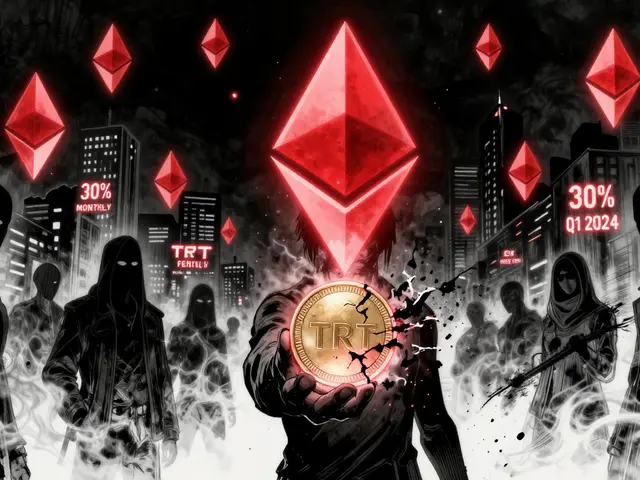PancakeSwap V3 (opBNB) Fee Calculator
Fee Calculation
Estimate your trading costs on PancakeSwap V3 (opBNB) based on trade size and selected fee tier.
Estimated Trading Costs
Trading Pair Overview
Current token pairs and their daily trading volumes on PancakeSwap V3 (opBNB).
USDT / WBNB
Volume: ~$7,784
Fee Tier: 0.05%
Market Share: ~73%
ETH / WBNB
Volume: ~$2,668
Fee Tier: 0.25%
Market Share: ~25%
CAKE / WBNB
Volume: ~$204
Fee Tier: 0.25%
Market Share: ~2%
Fee Comparison Table
Compare fees across various DEX options.
| Platform | Base Fee | Typical Gas Cost (USD) | Notes |
|---|---|---|---|
| PancakeSwap V3 (opBNB) | 0.05% – 0.25% (tiered) | ≈ $0.01–$0.03 | 25× lower fees than V2, Layer-2 gas advantage |
| PancakeSwap V2 (BNB Smart Chain) | 0.25% – 0.30% | ≈ $0.25–$0.35 | Higher fees, similar liquidity depth |
| Ethereum-based DEX (e.g., Uniswap) | 0.30% | ≈ $3–$5 | High gas, slower finality |
| Centralized exchange (Binance) | 0.10% (maker) | Negligible (off-chain) | Custodial, no on-chain control |
Pros
- Ultra-low gas fees on opBNB
- Concentrated liquidity boosts LP capital efficiency
- Smart Order Routing reduces slippage
- Integrated limit orders and TWAP bring CEX-like functionality
Cons
- Only three trading pairs currently available
- Liquidity-range management can be confusing for beginners
- Limited documentation specific to the opBNB deployment
- Reliance on Binance ecosystem introduces regulatory risk
If you’re hunting for a DEX that combines Binance‑chain heritage with Layer‑2 speed, the PancakeSwap V3 (opBNB) is a specialized version of the popular PancakeSwap DEX built on the opBNB scaling network deserves a close look. This review breaks down the platform’s core features, fee structure, token lineup, and real‑world usability so you can decide whether it fits your trading style.
What makes opBNB different?
The opBNB network is a Layer‑2 solution announced in 2023 to boost BNB Smart Chain performance. By moving transactions off the main chain, opBNB cuts gas costs dramatically while preserving BNB ecosystem compatibility. In practice, a swap that might cost $0.30 on BSC drops to a few cents on opBNB, and confirmation times shrink from 3‑5 seconds to under a second.
Key Features of PancakeSwap V3 (opBNB)
- Automated Market Maker (AMM): The exchange runs on an AMM model, meaning price curves are generated by liquidity pools rather than order books.
- Concentrated liquidity: Liquidity providers (LPs) can lock capital into narrow price ranges, improving capital efficiency.
- Smart Order Routing (SOR): The engine scans multiple pools to find the best price with minimal slippage.
- Limit orders & TWAP: Advanced order types let users set exact entry points or average‑price executions, features usually reserved for centralized platforms.
- Tiered fee structure: Fees vary by pair, rewarding high‑volume traders with lower costs.
Token Selection and Trading Volume
At the time of writing, the platform supports just three coins across three pairs:
- USDT / WBNB - accounts for ~73% of daily volume (~$7,784).
- ETH / WBNB - ~25% of volume (~$2,668).
- CAKE / WBNB - ~2% of volume (~$204).
Daily transaction values swing between $10,600 and $14,150, showing a healthy 21‑22% volatility that keeps fee revenue steady.
Fee Comparison at a Glance
| Platform | Base fee | Typical gas cost (USD) | Notes |
|---|---|---|---|
| PancakeSwap V3 (opBNB) | 0.05% - 0.25% (tiered) | ≈ $0.01‑$0.03 | 25× lower fees than V2, Layer‑2 gas advantage |
| PancakeSwap V2 (BNB Smart Chain) | 0.25% - 0.30% | ≈ $0.25‑$0.35 | Higher fees, similar liquidity depth |
| Ethereum‑based DEX (e.g., Uniswap) | 0.30% | ≈ $3‑$5 | High gas, slower finality |
| Centralized exchange (Binance) | 0.10% (maker) | Negligible (off‑chain) | Custodial, no on‑chain control |
How to Get Started
- Add the opBNB network to a compatible wallet (MetaMask or Trust Wallet are the most common). Input the RPC URL, chain ID (204), and symbol (BNB).
- Bridge assets from BNB Smart Chain or another supported chain using the official opBNB bridge.
- Connect your wallet to PancakeSwap V3 (opBNB) by clicking “Connect” on the homepage.
- Choose a pool, set your desired price range for concentrated liquidity, and confirm the transaction.
- If you prefer trading over providing liquidity, use the swap tab, set slippage tolerance, and confirm.
The UI mirrors the familiar PancakeSwap layout, so navigation feels intuitive for existing users. Newcomers may find the concentrated‑liquidity UI a bit steep, but tutorials on the community forums walk you through setting ranges step‑by‑step.
Pros and Cons - A Balanced View
| Pros | Cons |
|---|---|
| Ultra‑low gas fees on opBNB. | Only three trading pairs currently available. |
| Concentrated liquidity boosts LP capital efficiency. | Liquidity‑range management can be confusing for beginners. |
| Smart Order Routing reduces slippage. | Limited documentation specific to the opBNB deployment. |
| Integrated limit orders and TWAP bring CEX‑like functionality. | Reliance on Binance ecosystem introduces regulatory risk. |

Community Sentiment
Reddit threads and Telegram groups praise the fee savings and fast confirmations. Users regularly report transaction costs that are a fraction of Ethereum‑based DEXes. The main complaint circles back to the narrow token list - many traders want more pairs, especially stablecoins beyond USDT and popular DeFi tokens.
Future Outlook
Analysts expect opBNB adoption to rise as Binance expands its Layer‑2 roadmap. If the network gains traction, PancakeSwap V3 (opBNB) is slated to add new pairs, potentially bringing in BUSD, MATIC, and newer meme tokens. The platform’s roadmap also hints at cross‑chain bridges that could let users swap directly between opBNB and other L2s without an intermediate bridge.
Bottom Line
For traders who value low fees, fast settlement, and a proven AMM engine, PancakeSwap V3 review points to a solid, albeit still niche, offering. The trade‑off is a limited selection of assets, which may deter users seeking broad diversification. If you’re comfortable navigating concentrated liquidity and want to stay on‑chain, the opBNB deployment is a compelling step forward.
Frequently Asked Questions
How do I add the opBNB network to MetaMask?
Open MetaMask, go to Settings → Networks → Add Network. Fill in: Network Name: opBNB, RPC URL: https://opbnb-mainnet-rpc.bnbchain.org, Chain ID: 204, Currency Symbol: BNB, Block Explorer URL: https://opbnbscan.com. Save and switch to the new network.
What is concentrated liquidity and why does it matter?
Instead of spreading capital across the whole price curve, LPs choose a narrow price band where they expect most trades. This concentrates capital, raising fee earnings per dollar invested and reducing impermanent loss when the market stays inside the range.
Can I trade on PancakeSwap V3 (opBNB) without holding BNB?
Yes. You can bridge any supported token (e.g., USDT) to opBNB, then trade directly. However, paying gas still requires a small amount of BNB for transaction fees.
How does the fee structure differ between pairs?
Pairs with higher liquidity, like USDT/WBNB, enjoy the lowest tier (0.05%). Less liquid pairs may fall into the 0.25% tier. The platform automatically applies the appropriate fee when you execute a swap.
Is my crypto safe on a decentralized exchange?
Since you connect a non‑custodial wallet, you retain full control of private keys. The smart contracts have been audited, but no platform is risk‑free. Always use a hardware wallet for large amounts.









Tyrone Tubero
June 5, 2025 AT 02:25Yo, those opBNB fees are basically free, obviously for the elite.
Patrick MANCLIÈRE
June 12, 2025 AT 02:25When you stack the fee numbers side by side, PancakeSwap V3 on opBNB really stands out.
The 0.05% tier on the high‑liquidity pairs translates to pennies on a $10k trade.
That’s a stark contrast to Ethereum‑based DEXs where you pay a few bucks just for gas.
Layer‑2 on BNB also means transactions settle in seconds, which is a win for active traders.
The limited pair list is a drawback, but the concentrated liquidity model helps keep slippage low.
Overall, if you’re looking for cheap swaps without compromising speed, this deployment is worth a look.
Greer Pitts
June 19, 2025 AT 02:25I get why the small number of pairs can feel restrictive.
But the ultra‑low gas fees make even tiny trades economical.
For newcomers, the UI is fairly straightforward, just pick a pair and hit swap.
Stick with it and you’ll see the cost savings add up over time.
Lurline Wiese
June 26, 2025 AT 02:25Wow, the gas fee drop is like finding hidden treasure!
I was skeptical at first, but the numbers don’t lie.
Trading on opBNB feels as smooth as butter melting on a hot pan.
Still, the pair scarcity is a glaring hole in the experience.
Hope the devs expand the list soon, otherwise the hype fades.
Jim Griffiths
July 3, 2025 AT 02:25Start with the 0.05% tier for the biggest pools to keep costs down.
You can always switch to 0.25% if liquidity drops, but the fee increase is modest.
Matt Nguyen
July 10, 2025 AT 02:25One must acknowledge the subtle orchestration behind Binance’s ecosystem.
By anchoring PancakeSwap V3 to opBNB, they ensure a captive user base.
The fee structure appears generous, yet it subtly nudges traffic away from competing L1s.
Such design choices are rarely accidental; they serve a larger strategic agenda.
Stay vigilant, the narrative of 'low fees' may mask hidden dependencies.
Cynthia Rice
July 17, 2025 AT 02:25Cheap swaps whisper the promise of freedom.
Yet scarcity of pairs shouts the limits of this illusion.
Marc Addington
July 24, 2025 AT 02:25If you’re proud of crypto sovereignty, ditch the centralized exchanges.
PancakeSwap on opBNB shows how a home‑grown solution can undercut foreign platforms.
Don’t let foreign gas fees dictate your trades.
Amal Al.
July 31, 2025 AT 02:25Indeed, the spirit of independence shines through, and it’s encouraging to see a home‑grown alternative gaining traction, especially when it slashes fees dramatically, fostering a more inclusive ecosystem.
Natalie Rawley
August 7, 2025 AT 02:25Everyone’s buzzing about the fee drops, but let’s get real.
The platform’s architecture is simply a copy of Uniswap V3 with a BNB twist.
If you wanted genuine innovation, you’d look elsewhere.
This is just a re‑skin with cheaper gas, nothing more.
Scott McReynolds
August 14, 2025 AT 02:25I hear the criticism, but there’s a bright side to this evolution.
Lower fees democratize access, letting smaller players dip their toes without fearing hefty costs.
Even with a limited pair list, the concentrated liquidity model ensures better price stability.
As the community grows, we can anticipate new pools emerging, further enriching the ecosystem.
Think of it as a seedling: today it may be modest, tomorrow it could blossom into a forest of diverse assets.
Moreover, the swift settlement times enhance user confidence, especially for day traders.
The synergy between opBNB’s layer‑2 efficiency and PancakeSwap’s UI creates a smooth experience.
In short, patience coupled with active participation can turn these early days into a thriving marketplace.
Alex Gatti
August 21, 2025 AT 02:25I wonder how the fee tiers will evolve as more liquidity comes in the current model is flexible but could use more transparency because users deserve clear info about when to switch tiers also the token pair expansion will be crucial to attract diverse traders hope the devs listen
John Corey Turner
August 28, 2025 AT 02:25Indeed, the fluidity of fee structures mirrors the ever‑shifting tides of market sentiment, a reminder that economics is as much art as science; embracing this duality can empower traders to navigate with both logic and intuition.
Kimberly Kempken
September 4, 2025 AT 02:25The hype surrounding low fees is merely a veneer; beneath lies a deeper question about decentralization quality, and without robust governance the platform remains a fleeting convenience, not a lasting revolution.
Eva Lee
September 11, 2025 AT 02:25While your critique touches on governance, let’s not overlook the technical merit of concentrated liquidity, which substantially improves capital efficiency-a nuance often lost in broad‑stroke dismissals.
stephanie lauman
September 18, 2025 AT 02:25Honestly, the so‑called 'innovation' is nothing more than a cost‑cutting gimmick; if you compare the TVL and user adoption, PancakeSwap V3 on opBNB lags behind true competitors 😑.
Twinkle Shop
September 25, 2025 AT 02:25The introduction of PancakeSwap V3 on the opBNB layer‑2 constitutes a noteworthy milestone in the BNB ecosystem.
From a technical perspective, the migration leverages optimistic rollup technology to achieve sub‑cent gas costs, which is a substantial improvement over the BSC mainnet.
Such reduction in transaction overhead directly benefits market makers, allowing them to allocate more capital toward liquidity provision rather than fee consumption.
Moreover, the concentrated liquidity model adopted from Uniswap V3 enables LPs to define custom price ranges, thereby enhancing capital efficiency.
This mechanism, while powerful, introduces a layer of complexity that may deter novice participants who are accustomed to traditional uniform liquidity pools.
Nevertheless, the trade‑off is justified for traders seeking tighter spreads and reduced slippage, especially in high‑volume pairs like USDT/WBNB.
The fee tier architecture, ranging from 0.05% to 0.25%, reflects a nuanced approach to balancing revenue generation with user incentives.
In practice, the lower tier applies to deep‑liquidity pairs, ensuring that large trades incur minimal fees, which can be a decisive factor for institutional actors.
Conversely, the higher tier serves less liquid pairs, protecting LPs from excessive impermanent loss.
A critical observation concerns the current scarcity of listed token pairs; expansion of the catalogue will be essential to sustain long‑term network effects.
Community governance will likely play a pivotal role in determining which assets are onboarded, necessitating transparent proposal processes.
From a security standpoint, the optimistic rollup model relies on fraud proofs, which, while efficient, require vigilant monitoring to mitigate potential attack vectors.
The integration of limit orders and TWAP functionalities further bridges the gap between decentralized and centralized exchange experiences.
Users should also be aware of the regulatory landscape surrounding Binance-affiliated platforms, as jurisdictional scrutiny could impact future development.
Overall, the synthesis of ultra‑low fees, rapid finality, and advanced order types positions PancakeSwap V3 on opBNB as a compelling alternative for cost‑conscious traders.
Future roadmap milestones, such as expanding multi‑chain support and enhancing analytics dashboards, will determine whether this platform can maintain its competitive edge.
Carthach Ó Maonaigh
October 2, 2025 AT 02:25Sure, because everyone totally trusts a jargon‑filled manifesto over actual product updates, right?
Brooklyn O'Neill
October 9, 2025 AT 02:25It’s great to see enthusiasm, but remember that educating newcomers about fee tiers and liquidity management can foster a healthier community. Providing simple guides and hands‑on tutorials will lower the entry barrier. Encouraging questions in a supportive tone helps users feel safe. Let’s keep the conversation constructive.
Adarsh Menon
October 16, 2025 AT 02:25Wow amazing how cheap swaps are like magic dont need to pay any gas lol
Laurie Kathiari
October 23, 2025 AT 02:25While your excitement is noted, glorifying fee cheapness without acknowledging the underlying centralization risks is irresponsible and misleads naive participants.
Promise Usoh
October 30, 2025 AT 02:25In contemplating the emergence of layered DEX solutions, one must ponder the dialectic between efficiency and autonomy. The opBNB implementation exemplifies a pursuit of low‑cost execution, yet it simultaneously entwines users with a broader ecosystem. Such entanglement invites scrutiny regarding true decentralization. As scholars of blockchain philosophy, we are tasked with interrogating these trade‑offs. Only through rigorous analysis can we delineate the path forward.
Shaian Rawlins
November 6, 2025 AT 02:25I love seeing new tools that make crypto more accessible for everyday people.
The low fees on PancakeSwap V3 opBNB really lower the barrier for small investors.
When you can trade a few dollars without losing most of it to gas, you feel empowered.
At the same time, the limited number of pairs means there is still room for growth.
I hope the team adds more popular tokens soon, because diversity helps keep the market healthy.
Education is key, so tutorials that explain how concentrated liquidity works would be fantastic.
Simple step‑by‑step videos could guide newcomers through setting up limit orders.
Community events, like liquidity mining contests, can also bring more users into the fold.
It’s important that we keep a positive vibe and help each other learn.
If someone runs into a problem, quick support from the devs or moderators makes a big difference.
I’ve seen many projects falter because they ignored user feedback.
Listening to the community builds trust and leads to better product decisions.
Overall, the combination of cheap fees and fast settlement is a strong foundation.
With the right incentives and clear communication, this platform can thrive.
Let’s stay optimistic and work together to make decentralized finance truly inclusive.